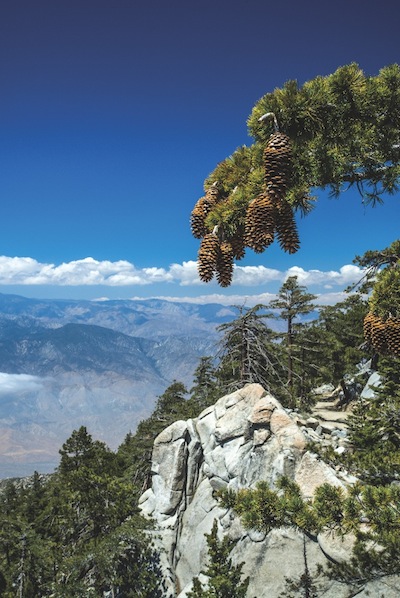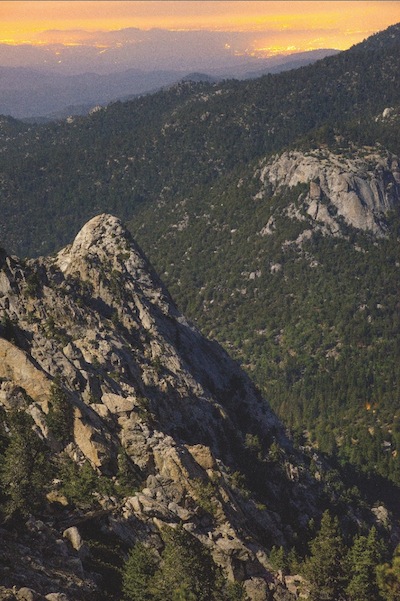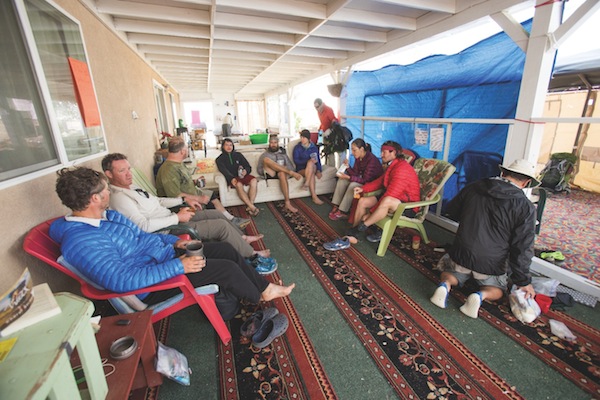
If you happen to be hiking a portion of the 57-mile slice of the Pacific Crest Trail (PCT) that begins off Highway 74 in Palm Desert, you might notice something remarkable: lots of other hikers. Cheryl Strayed, author of the international best seller Wild: From Lost to Found on the Pacific Crest Trail, has popularized the trend of the intentionally solo hiker.
Thousands have chosen the PCT in order to emulate Strayed’s journey, a gruelling quest that may lead to a physical and spiritual transformation. The PCT Association estimates that the number of hikers on the trail has increased by 300 percent in the past three years. The impact has been so significant that the association now limits the number of hikers who start the trail each day at its southernmost point to 50.

Hikers emerging from the Interstate 10 overpass with Mount San Jacinto towering 10,840 feet above them.
Strayed began her PCT trek not only laden with a pack she could barely carry, but with emotional baggage. Heartbroken after the death of her beloved mother and the subsequent end of her marriage to a man she loved, she was weighted by grief and confusion. She was literally and metaphorically lost. Along the way she confronted — and eventually overcame — the physical and emotional limitations that had been holding her back. It’s an inspiring story that moves through the crucible of hardship to a triumphant ending.
What are Strayed’s thoughts about this new generation of intrepid hikers who are literally following in her footsteps? “I feel honored and amazed that Wild has inspired so many people to go hiking, whether that be on the PCT or another trail,” she says. “The number of hikers on the PCT has greatly increased and that thrills me beyond words.”

The Fuller Ridge area overlooking the Banning Pass far below it.
It’s not only the number of hikers that has increased; more and more writer/hikers are blogging about their experiences on the trail. The bloggers retracing Strayed’s journey have various intentions, but all are keen to challenge themselves, body and soul, with the hope that there will be a payoff similar to the one Strayed experienced — a healed heart and positive life changes. That Wild was made into a movie starring Reese Witherspoon as Strayed only strengthens the appeal of the PCT for determined pilgrims who set off on this 2,650-mile, American secular version of the Camino de Santiago, the increasingly popular but centuries-old pilgrimage routes through France and Spain to the shrine of the apostle St. James in Galicia.
Though Strayed started her journey north in Mojave and never got to see the lights of the valley below her, most hikers begin their treks in Campo, a town in southeastern San Diego County. It takes about a week to reach Highway 74, where our section of the trail begins 23 miles from Palm Desert. Hikers enter a pint-sized forest of ribbonwood, yucca, and manzanita as they thread their way along the spine of the San Jacinto Mountains. After a side trip into Idyllwild for Neosporin and Band-Aids, the PCTers head up the Devil’s Slide Trail and soon get their first glimpse down into Palm Springs. Here they hit the 200-mile mark, then descend 7,000 feet in 20 miles into the dreaded wind tunnel — four miles of sand and gusts so fierce they can leave welts on hikers’ cheeks from flapping hat strings.

A view from the PCT toward the lights of Hemet and San Jacinto.
In her blog The Traveling Mandolin (thetraveling mandolin.blogspot.com), hiker Lisa Strader wrote about this particularly arduous section of the trail. “Today was the first day we realized what windmills really are: signals of the presence of murderously strong wind … that four miles across the plain were some of the longest miles of the entire trail.” Strader describes finding relief in what she calls “trail magic”:
In the midst of our misery and murderous thoughts, we stumbled upon the first trail magic. There was a cooler with big sheets of cardboard hanging up on the bridge behind it. On top of the cooler sat a bunch of bananas.

The Pacific Crest Trail as seen at dawn.
In a dream, I picked a banana from the bunch and stared at it. I peeled the banana and bit into it. It was green, almost to the point of being crunchy, but it was the best banana I had ever eaten. Check that — it was the best thing I had ever eaten. Ever. It was the food to end all food, an explosion of flavor and coolness and moist fruity flesh. It made life worth living again. Suddenly, I didn’t want to murder someone. I wanted to hug everyone and dance and sing for joy. I’ve had many beautiful and intense experiences in my life, but eating that banana had to be up in the top three.
As on the Camino de Santiago, a network of trail caretakers called trail angels have positioned themselves within reach of the trail to help hikers on their journeys. Trail caretakers are especially revered in the descent down Mount San Jacinto, as evidenced in the blog Jesse’s Long Walk (www.jessewiegel.com), in which Jesse Wiegel, who is currently hiking the PCT, encountered a couple known as “Ziggy and the Bear,” forerunners of those folks who have become known as trail angels:
Friday, after I walked down Mount San Jacinto and battled the Wind Gods in the I-10 corridor, I came upon “The Whitewater House” — the home of Ziggy and The Bear, trail angels extraordinaire. It was 4:30 in the afternoon, I had hiked 23 miles, descended 7,000 feet, and had limped most of it on some seriously painful legs …
Ziggy and the Bear have been hosting Pacific Crest Trail thru-hikers since the 1980s. For a number of years, they ran their operation out of a house in Anza, California … The house that they are now in was purchased specifically for the purpose of Trail Angel-ing … There were facilities for handwashing of clothing, a solar shower, three big hiker boxes bulging with food and gear, hot coffee at all times, hot water with complimentary cocoa, tea, and apple cider.

The patio at Ziggy and the Bear’s house where countless hikers have recovered from crossing Banning Pass.
When asked why she thinks people would take on a journey such as the one she describes in Wild, hiking enthusiast or otherwise, Strayed says, “I think people hike for many reasons: the physical challenge, the wild beauty of the land, and yes, spiritual renewal. Taking on a long hike on a trail like the PCT is inevitably life-changing.”
The poet Zbigniew Herbert wrote, “If you set out in a journey, let it be long.” We are forged in the fires of our experiences, mentally, physically, and spiritually. In the end, it’s not about who is doing (or reading) what, who hikes alone, or who prefers a group that matters. The power of hiking — be it in the Coachella Valley or elsewhere — of the challenge it creates and the community it can bring about, gives us the sense of being, as Robb writes, “feral and free” in a modern world with its modern problems. This, and this alone, has great value.
As Strayed writes:
“It had nothing to do with gear or footwear or the backpacking fads or philosophies of any particular era or even with getting from point A to point B. It had to do with how it felt to be in the wild. With what it was like to walk for miles with no reason other than to witness the accumulation of trees and meadows, mountains and deserts, streams and rocks, rivers and grasses, sunrises and sunsets. The experience was powerful and fundamental. It seemed to me that it had always felt like this to be a human in the wild, and as long as the wild existed it would always feel this way.”

Contrasting colors of the Pacific Crest Trail.